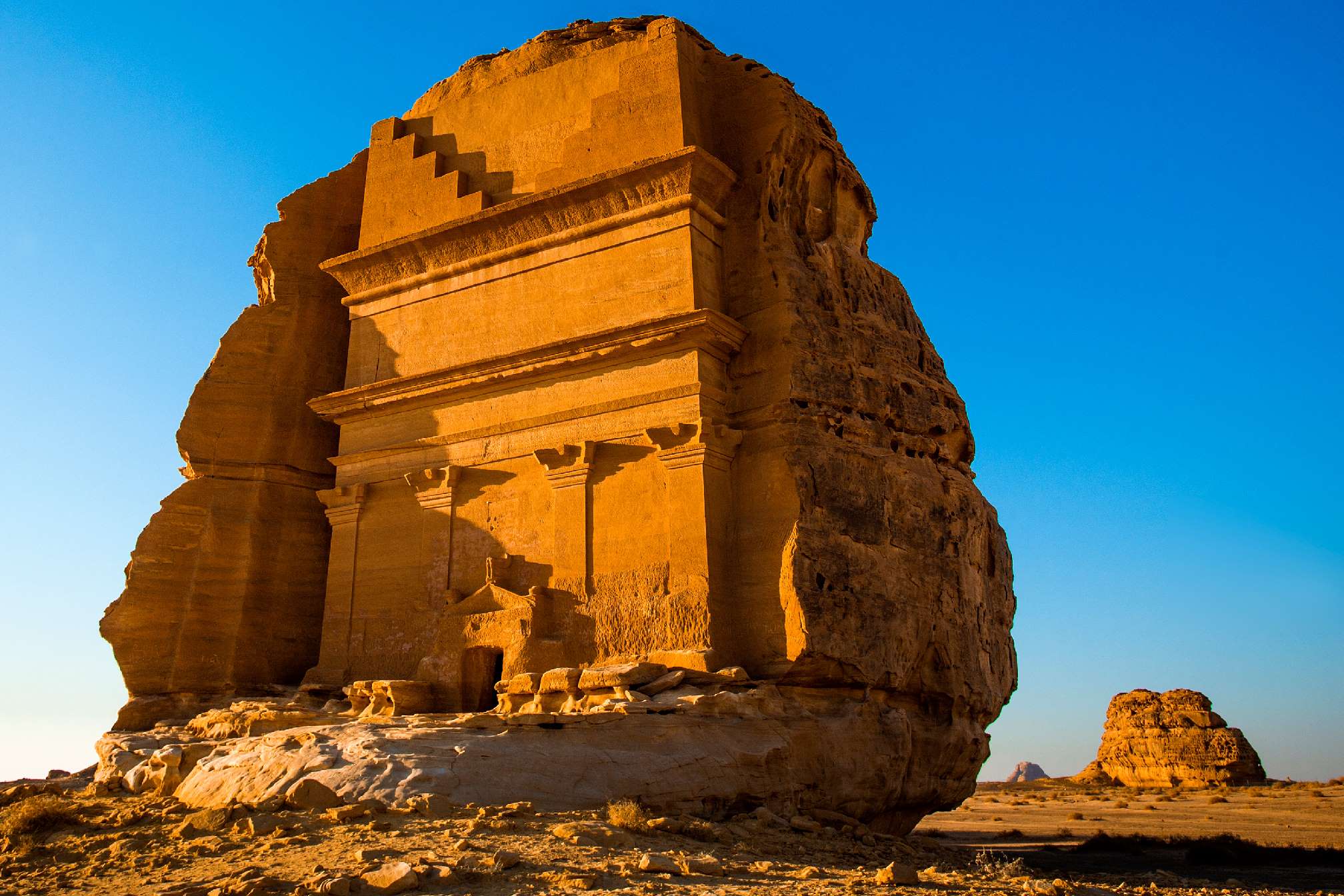
Have you ever heard of Hegra, also known as Mada’in Salih? This ancient city, located in Saudi Arabia's Al-'Ula region, was the second capital of the Nabataean Kingdom after Petra. Hegra is famous for its over 100 rock-cut tombs, intricate architectural designs, and sophisticated water management system. Recognized as a UNESCO World Heritage Site, Hegra offers a glimpse into a multicultural past, blending Nabataean, Roman, and Hellenistic influences. Rediscovered by European explorers in the 19th century, Hegra continues to reveal its secrets through ongoing archaeological excavations. Ready to learn more about this historical gem? Let's dive in!
Key Takeaways:
- Hegra, also known as Mada’in Salih, is an ancient city in Saudi Arabia with over 100 rock-cut tombs and a sophisticated water management system, showcasing the diverse cultural influences of the Nabataean Kingdom.
- Recognized as a UNESCO World Heritage Site, Hegra offers insights into the lives of the Nabataeans and other civilizations through its architectural marvels, inscriptions, and historical significance.
Location and Historical Significance
Hegra, also known as Mada’in Salih, is an ancient city with a rich history. Its significance lies in its strategic location and its role in the Nabataean Kingdom.
-
Hegra is situated in the Al-'Ula region within Medina Province in the Hejaz region of Saudi Arabia. This location made it a crucial point along ancient trade routes.
-
Hegra served as the second capital of the Nabataean Kingdom, following Petra in Jordan. The city was a major center of trade and commerce along the Incense Route.
-
The city features over 100 rock-cut tombs. These tombs are intricately carved into sandstone cliffs, showcasing the skilled craftsmanship of the Nabateans.
Architectural Marvels and Cultural Influences
Hegra's architecture is a blend of various cultural influences, reflecting the diverse civilizations that once inhabited the region.
-
The architecture of Hegra reflects the cultural influences of different civilizations. Visitors can find a mix of Nabataean, Roman, and Hellenistic architectural elements.
-
Hegra boasts a sophisticated water management system. This system includes reservoirs, wells, and underground channels, ensuring a reliable water supply.
-
Numerous inscriptions are carved into the rock surfaces of Hegra. These inscriptions come in various languages, including Nabatean, Ancient Arabic, and Greek.
Trade and Commerce
As a major hub along the Incense Route, Hegra played a vital role in ancient trade networks.
-
Hegra was an important center for the trade of valuable spices and incense. Its strategic location made it an essential stop for merchants.
-
The city flourished as a major Nabataean settlement from the 1st century BCE until the 2nd century CE. This period marked the height of its commercial importance.
-
Hegra was rediscovered by European explorers in the 19th century. This rediscovery brought international attention to its historical significance.
UNESCO World Heritage Site
Hegra's recognition as a UNESCO World Heritage Site underscores its importance in preserving ancient architecture and cultural heritage.
-
Hegra was recognized as a UNESCO World Heritage Site in 2008. This designation highlights its significance in preserving Nabataean architecture.
-
The geology of Hegra provided the perfect medium for carving monumental structures. The sandstone cliffs allowed for intricate rock-cut tombs.
-
The facades of Hegra's tombs feature inscriptions in Nabatean scripts. These inscriptions provide valuable information about the Nabataeans.
Oasis Agriculture and Roman Influence
The Nabataeans developed innovative agricultural practices and experienced Roman occupation, which influenced the city's development.
-
The Nabateans developed oasis agriculture in Hegra. They dug wells and rainwater tanks in the rock, allowing the city to thrive.
-
Traces of Roman occupation can be found in Hegra. The city was under Roman rule after the decline of the Nabatean Kingdom.
-
Hegra began to decline as a center of trade when maritime routes became more popular. This shift led to its eventual abandonment.
Historical Accounts and Ottoman Era
Historical accounts and the Ottoman era provide additional context to Hegra's rich history.
-
Hegra served as a station along the Hajj route. It provided supplies and water for pilgrims.
-
The Ottoman Empire annexed western Arabia from the Mamluks in 1517. However, Hegra was not mentioned in early Ottoman accounts until 1672.
-
A fort was built at al-Hijr between 1744 and 1757. This fortification marked a significant period in Hegra's history.
Archaeological Excavations and Tourism Development
Ongoing archaeological excavations and tourism development efforts are crucial for preserving Hegra's cultural heritage.
-
Ongoing archaeological excavations have revealed the true extent of Hegra’s historical significance. These excavations have uncovered numerous artifacts and inscriptions.
-
Hegra is now being promoted to tourists for the first time. This offers a unique opportunity to explore its ancient ruins and rock-cut tombs.
-
Hegra’s commercial importance is underscored by the inscriptions found on the tombs. These texts reveal the diverse composition of Nabataean society.
Nabataean Inscriptions and Architectural Marvels
The inscriptions and architectural marvels of Hegra provide valuable insights into the lives of the Nabataeans.
-
About 7,000 Nabataean inscriptions have been found throughout their kingdom. However, only a little over 100 of them have dates.
-
Some tombs at Hegra are the final resting places for high-ranking officers and their families. The inscriptions indicate that they adopted Roman military titles.
-
Hegra contains numerous architectural marvels, including rock-cut tombs with capital-topped columns and triangular pediments. These structures showcase the skilled craftsmanship of the Nabateans.
Sphinxes, Griffins, and Historical Timeline Gaps
The tombs at Hegra feature various symbols and help fill in gaps in the Nabataeans' historical timeline.
-
The tombs at Hegra feature sphinxes, eagles, and griffins with spread wings. These symbols were important in the Greek, Roman, Egyptian, and Persian worlds.
-
Hegra’s oldest dated tomb is from 1 B.C., and the most recent from 70 A.D. These dates help fill in gaps on the Nabataeans’ timeline.
-
Hegra is a cultural treasure trove, offering insights into the lives of the Nabataeans and other civilizations. The site’s blend of architectural styles and historical significance make it fascinating.
Guided Tours and UNESCO Recognition
Guided tours and UNESCO recognition have helped raise awareness about Hegra's historical significance.
-
Visitors to Hegra can experience the site through guided tours. These tours provide a deeper understanding of the city’s history, culture, and architecture.
-
Hegra’s recognition as a UNESCO World Heritage Site in 2008 underscores its importance. This designation has helped raise awareness and encouraged tourism development.
-
Archaeological discoveries at Hegra have revealed a rich history spanning over two millennia. The site has yielded numerous artifacts and inscriptions.
Historical Accounts by Travelers and Ottoman Influence
Historical accounts by travelers and the Ottoman influence provide additional context to Hegra's rich history.
-
Historical accounts by travelers such as Ibn Battuta and Evliya Celebi provide valuable information about Hegra’s past. These accounts describe the city’s architecture and its role in trade.
-
The Ottoman Empire’s influence on Hegra is evident in the fort constructed during the 18th century. This fortification marked a significant period in Hegra’s history.
-
Ongoing archaeological excavations at Hegra continue to uncover new information about the site’s history and cultural significance. These excavations are crucial for preserving the site’s cultural heritage.
Tourism Development Challenges and Cultural Exchange
Tourism development in Hegra faces challenges, but also presents opportunities for sustainable practices.
-
Tourism development in Hegra faces several challenges, including preserving the site’s cultural heritage and managing the influx of tourists. These challenges also present opportunities for sustainable tourism practices.
-
Hegra reflects the cultural exchange and influence between different civilizations. The site’s architecture and inscriptions demonstrate the blending of Greek, Roman, Egyptian, and Persian influences.
-
Hegra’s historical legacy extends beyond its architectural marvels and cultural significance. The site serves as a testament to the ingenuity and craftsmanship of the Nabateans.
-
The site’s recognition as a UNESCO World Heritage Site ensures that its legacy continues to inspire future generations. This designation highlights the importance of preserving ancient Nabataean architecture and cultural heritage.
Hegra's Timeless Legacy
Hegra, also known as Mada’in Salih, stands as a testament to the ingenuity and craftsmanship of the Nabataeans. This ancient city, with its rock-cut tombs, sophisticated water management system, and blend of architectural influences, offers a unique glimpse into a multicultural past. Recognized as a UNESCO World Heritage Site, Hegra's historical significance is undeniable. From its role as a major trade hub along the Incense Route to its intricate inscriptions and tombs, every corner of Hegra tells a story. Ongoing archaeological excavations continue to uncover new facets of this ancient city, ensuring its legacy endures. As tourism develops, preserving Hegra's cultural heritage while making it accessible to a wider audience remains crucial. Hegra is not just a relic of the past; it's a vibrant link to our shared human history, inspiring future generations.
Frequently Asked Questions
Was this page helpful?
Our commitment to delivering trustworthy and engaging content is at the heart of what we do. Each fact on our site is contributed by real users like you, bringing a wealth of diverse insights and information. To ensure the highest standards of accuracy and reliability, our dedicated editors meticulously review each submission. This process guarantees that the facts we share are not only fascinating but also credible. Trust in our commitment to quality and authenticity as you explore and learn with us.


